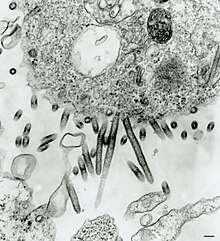| Tibrovirus | |
|---|---|

| |
| Sweetwater Branch tibrovirus (530 nm to 690 nm and up to 900 nm long, 65 nm to 75 nm in diameter)[2] | |
| Virus classification | |
| (unranked): | Virus |
| Realm: | Riboviria |
| Kingdom: | Orthornavirae |
| Phylum: | Negarnaviricota |
| Class: | Monjiviricetes |
| Order: | Mononegavirales |
| Family: | Rhabdoviridae |
| Genus: | Tibrovirus |
| Species[1] | |
| |
Tibrovirus is a poorly characterized genus of viruses in the family Rhabdoviridae, order Mononegavirales. There are 8 members of the genus.[3] Tibroviruses have been isolated from biting midges, cattle, and humans. None of the tibroviruses, except for Bas-Congo virus, have been associated with any diseases.
BHV, BAV, SWBV and TIBV were isolated from biting midges, suggesting that midges are the major arthropod vector for these viruses. It is not known how BASV, EKV-1 and EKV-2 are transmitted.[citation needed]
Tibroviruses are highly divergent. For example, overall amino acid homology among the human-associated tibroviruses (i.e. BASV, EKV-1 and EKV-2) ranges from 33% - 39%.[9]
Tibrovirus virions are enveloped, but only the morphology of Tibrogargan virus and Sweetwater branch virus have been observed by electron microscopy.[2]
| Genus | Structure | Symmetry | Capsid | Genomic arrangement | Genomic segmentation |
|---|---|---|---|---|---|
| Tibrovirus | Bullet-shaped | Helical | Enveloped | Linear | Non-segmented |
Tibrovirus genomes are single-stranded, negative-sense RNA molecules approximately 13 kb in length. The genome encodes for the typical five proteins found in all rhabdoviruses: nucleocapsid (N), phosphoprotein (P), matrix (M), glycoprotein (G), and polymerase (L). However, there are three additional genes, U1-U3, that encode for proteins of unknown function.[13]
Viral replication is cytoplasmic. Entry into the host cell is achieved by attachment of the viral G glycoproteins to host receptors, which mediate clathrin-mediated endocytosis.[14][10] Replication follows the negative-stranded RNA virus replication model. Negative stranded RNA virus transcription, using polymerase stuttering is the method of transcription. The virus exits the host cell by budding, and tubule-guided viral movement.[citation needed]
| Genus | Host details | Tissue tropism | Entry details | Release details | Replication site | Assembly site | Transmission |
|---|---|---|---|---|---|---|---|
| Tibrovirus | Bovine | None | Clathrin-mediated endocytosis | Budding | Cytoplasm | Cytoplasm | Zoonosis; arthropod bite: midges |